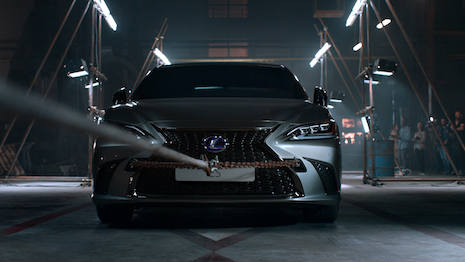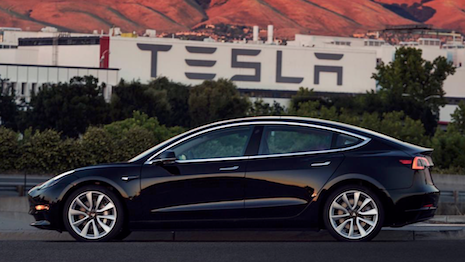Currently the automotive industry is exceptionally competitive, as customer loyalty becomes less solid thanks to marginal differences between sectors when it comes to quality.
According to the MaritzCX New Vehicle Customer Survey, both luxury and non-luxury segments are most interested in blindspot warning, cross-traffic alerts, lane departure warning and auto brake assist in terms of in-vehicle technology. Sport utility vehicles and ride sharing continue to be disruptors for automakers, with 49 percent of consumers being most interested in SUVs and the number of ride sharing users growing 4 percent in one year.
“In almost every segment you see how closely bunched the entries are,” said Shawn St. Clair, senior director of syndicated and autonomous research at MaritzCX. “With five factors – comfort, quality, performance, safety, cost of ownership – being used for scoring, one would expect to see large differences.
“The difference between winning a segment and middle of the pack is being average in a single factor,” he said. “You have to offer great vehicles based on multiple factors.
“These razor-thin margins show how competitive each segment is and how customers could easily defect to a different product. Manufacturers need to understand what areas they are behind and attack these deficiencies immediately.”
Driving auto insights
For premium models in North America, Tesla’s Model 3 saw the highest consumer ratings across comfort, quality, performance, safety and ownership cost for small car. Tesla’s Model S won out for mid-size sedan, and its Model X was top rated for midsize SUV.
The Lincoln Navigator had the highest rating for a large SUV and the Porsche Macan took the top score for the small SUV category.
The report shows that in 1998, cars were the driving force in model type with 52 percent of sales. But 10 years later, SUVs have the majority at 49 percent and cars see only 34 percent of total sales.
The population of ride-sharing users has grown 4 percent from 2017 to 2018, with 29 percent of consumers saying they have used a ride-sharing service. Thirteen percent of car buyers cited how a potential vehicle would be as ride-sharing cars when shopping.
Japanese brands are on the rise, with interest growing 18 percent in the United States market within 10 years. From 1998 to 2018, European brands also rose 3 percent, while Korean brands increased by 7 percent.
 The Lexus ES. Image credit: Lexus
The Lexus ES. Image credit: Lexus
U.S.-based automakers dropped by 28 percent in that same time period.
Additional data
As regulations across the world strengthen and consumer demand changes, luxury automakers have the difficult task of building SUVs with little emissions while maintaining exclusivity.
Outside of the United States, emissions regulations are becoming increasingly stricter as the world looks for an answer to the global climate crisis. These new parameters are forcing luxury automakers to get creative with their designs to keep the power and exclusivity that they are known for, at the same time as the SUV becomes ubiquitous, according to panelists on Luxury Daily’s automotive webinar on June 12 (see story).
Britain's Aston Martin is the most recent luxury automaker to update its experiential offerings in an effort to draw a new class of affluent drivers.
From pop-ups to exclusive test drives, more automakers are taking luxury experiences to a new level. While some are geared towards current owners, other experiences are meant to make high-end vehicles more accessible (see story).
“The difference between premium and mass-market brands has continued to shrink,” Mr. St. Clair said. “Mass-market customers have demanded higher quality and performance, more comfort and additional safety features, and their collective voice has been heard loud and clear.
“Mass-market manufacturers are packing more and more content into their offerings and continuing to blur the line between premium and mass-market products,” he said.
{"ct":"xeLJRPX978BMa7h\/FK6grvBqRXRJmEClIOLEGrhzn9R7IcSsy7382bI6N1u6MGjO7vQ6mS5i8NeQ45reJ0p3\/StuHF\/Umf1rcMFl1sxs8H3IfzuGJMmt6EMjGDYeBmuJ8wAXooELrGfDfu6fDUW89XVBYtgvGkHLCNOexbD2Stf\/Vj68JkscYWZsZKIjhul5oMYGTx8mKty1t6Jzx23yInJBcDsgB5RFvMFFVbGJC9QYg6u4F4mNFwwzOUu0GWHYDQ8gOs1R1kXIVsXwePTRhFfyePhiscL66gGfSV+5a1Q3qYyJi7dV1V7VCLAxgrEOjhEajODArjomI+Nygeu1t8nJniXvFpcAuFo6OjKKiXpcHkXnBj01hNgMzNGrk5PQxOtMJnkEAqFTui5ZLDY3dMUlJf8\/v5zEJ+PlWunAV+Gkrtz+inPz1Rf6sJleSAHClWDdvGKXafcdkfjhdrmDaToWiE0bd5h1JK1ciTDLWeVfTwyRx3ZwFKhk01KAMSAmDoQW1e4TS7FHMg5gO4yORyHDLiYqSmzw15pjcAjls8TZqPJ\/u\/\/DLkRVLYGxQ0GnbtQxU8SaP7s6JcMhII\/nwoqUbGRmZM4rtKTPwBDkxblFn20mHvxfUIeWETQdnbvTVy0Iw2ofHB7n9wCo\/x0no+LRM0OupHTmvk\/iZuFyoTV7AEQlaCk78w2UL+X\/s2IiPNTSc5FMp1iV0fsBEkNl6SbfgXfczvLcd22yko+Ber8EaNRCMg0eB+nLJZF0UBdcdukBstN2+zndwulKAwPj6BfgjoEJBUNI3P3X7jFIH5RhRzefP2bg3LPm+wIl843MPggggY79S4usebGC+iIU9NCK\/ixoA9QuxktzJ4v36NiHT1hgfWjzVXXIw4jofipZA0UUS5UP9R4K6eOS9sffBlkNZCQNiTuln0fN418zIZvTcp5wjGiYGW3NxvOT1CW1Krcs45V3biP2ZgRpyi6oxxdB6udxWumalqAcwhMJUfsZLVFLPJ1RqNwoM1AgGTzzKbhA\/8dj4igdhHLA2h8vldw1ZGBo\/qrRE2CFDVhQk45\/tOb+v\/Xu\/TsS5pJuUo+jZeI8EJP3afGVL+J1ySes9JD84Y\/GT8aEvqxSFqPhlHZJMs1A9JV7dff+2q7RPk5v8ST3B3tF3REsYIH9BEvbp4q6QltzBc3CVET2GPeyMK3TS411G+qGAraY\/rq2fdPCZanGGZc9EiNYb+G3hH0qjml1btDd\/JbPgtWHTl9S8xUhv11vsEQ88R8MK60Z3MM6\/NQvlZrIYKQMwgHjMomQesra+gI5HLXFFZB5f24q1UlDFN0rOi7JnxKQhiQydjIiJTC1kMlskrzLOe8uZF7ifYfw2YE1Q8qi5uANNZNvG9RD2YmtZ\/8HbOV85TfzrLAJ7JgYegE2zycwDyUP1on+cdisqzWW9z8qkjbUchNhiF\/J9pUe0eWWnC2rGoyDVCSXqAzT4lv\/OZBaMNdRfGzJHKCTJ99h3iT1iGTB1zCHAgPN159HJZjlIm5WzAXUQGNzoFba6Cf2dI2+9NeEd\/LQf9CCfctr8CJOicAxYkbVvyANtrfL++4VxRd0ObBQREEwpCWrg1CXF+7Ni1XrHK+DRrtcunJOnZDGRfJKVBg1bYRy+xnMX467kJJEnlVGH1t+91khWMhczAXDQe2AioDia66TdHFRAXnfMkHPuQtDiNv5A\/oAz3l+vhzw0EulIbRua0uFRA4GkXv1ENpjldf3EX+Wdo9ii1os4giZDlWrT6FBmSr9PqZ7il5+rNqVtEQRWfBM80lGdNiZbpf2vLgyfoxHDxibOOyUySLSZROvkejNKTu4sWEp2QJg+oqsp\/bFWDGcdF5buD2gtktL5\/+9ad3EVZISiOy\/SHDVWnpJlJfWT5+2wOYQrUUhZ1ANz+17sCO7C1uQsbku\/DreEKCMExTpsr+ZV8VRNSEBNzOH5x4BYVFOGXcQuq5AArqDtneopb2b1R6pKPViinyL5c3v000klrupEtgW58L3HUFlWNBE6N9VQvb9oMwNcTGOGxFW\/IWJPWjNAfYHGpybMzo\/jrgWwhB7VStZC1fKz1bVnRsEe82NPndjTwgBG6S0QB4b1mRGb2RW0lLbeVLuOkxoPjaxoulq90WdRODkSiXEkDMNfoBUCXjken14ep\/NL8f7rYfO74YH0NIezkPb3tVLXhziTFJP+IUaLL\/RmR94tzD+jTtUhRRFu\/iizyJ9mUZT6aJ\/UBZkivCSDVEx2TUzG87PmBls572pWnyu4g+snD0Kq51Ou2eVg24yGSeu3RWh+5\/ul1hXjxT0SOvDWkJ6ItsIXTlXRp6mT02gJFYz49tX8mnZZxx41X6eJmBkF8Hs0Fh7Sf64bttBZ9FbYZ7Xyr40pYMuO7gFremPWLdIaZS0xni4SaizLp705E39lFsR55GAScM3F8IFMDoR0UqFRqve7HidTHDKFtgxzw3jRpjaFMe8CGtGSXZ5RZJUFv9XktnAE5qL8iSr5tS0hwOkmUOcLNIvqrOAEx1b\/zIYpgiNusNY+TiJHDUWiRKmVNFSP52ibIuUKDfzcXBij2URGIoUVZyClCgimbBmB7caM63Ha2xjbyYx0tPI2LAkjcl1f2P0IkLOckG4FjGZt\/RrjuWV1UcUoe2JTHTI8rPnbuufbPBXRYnTJPENDuv5XSiBhjtdzqTtaYuI6WcnK6M9h4\/1qwzHXyuES\/G9gurKTWTnNcWsgXZmpBRMYPPNxdo5rIwZzbFFngVWocGEI1R4MCgosrSVKxGPpaasz7tDWEh7GaJ259GJvgSjIE9cccsvC37oefPP+pt1bw7ZcvVmaCKsq1XkIzgFX\/L8A5oLHhnO+6st5pbECh4XDM0emxSTVjZE8mBs7i1COBiOxnRDHVuW\/oPBoIjlZHVuYsAzkHciswbwCmY+l6k6z90UNiZ4QdfinSCDsvjM+LvTXyMb5gEioHm1DJhlOHUMMEwKhyASt50SR4\/ZBJOH9ZReGF9nof9Bf5xSLBBaCK6YV34jhITywuMHmzhokVExJhl5mbm12nSsXkP+vGUokGwNa5XGD1fS\/JyY+WBRqa2lCFCVRDnDw8uCQKLXDObRSqPCK8NVE7j4ogjoW6SqCIDkGnhzQZreMUX4W6WfqVqHcZEVpOxpMAQwbtwPReJRrbfJgUB7WrC+k0alhy2dyCk59xEuSDjn8BetMBlxQWJcWIu0snHj7jEDinDIJqQv\/JV8+4gYpw6VDBv3olE2islfd62GSuLoey7sfPe7VdgcH2FRf6W0akm\/98APvENdt9NwUNma77jItHLKp\/gfnRfyK2el2mDjkg36UTUxeuR7fJzljZ\/SHujIYHBPGOzmhqSe4DSAufqFki\/DTypij\/bdw35Xes5Tq1uPqHZvMzB\/1WYZF6JsJRkwLYBfjTOriGhqWx5DZ1sAEd0VKfPfyfGdBzP9Y96nUmy1LzECYn25MiNcQ3hYxl6F+xn1OfhxwCjdyWixvemO+PGjMVc13OkCpDEj+EMTSPWB333JCZT84G8kWZ3LQiPZXt\/ZoDePvf\/oEhh7X3UiKGJfZa1E6urcVG6povywLCLD2cdd0DVr0BUqGb5j4NEaImAi9J0D3t5Q3gPOlahM92mO+Q+wq4yTlyYnbMVWm1sD1wwQlYfl55i8qiYODYH+pIQPJlLAAbERJcZ9SI4y6VbOCkAUEXwv1L0IN6LI903IaUUBFL3GzeAc1T1in7+e889at2MG9+TE\/cUTtdPBx1MRFVy+yJJssKyU5CHLF0IKQvQqmZTfQw+LvIucIaSeR5fa2s7ax9ofyQFMQkXhuh5r+zF96WpBj01BwMHN7naDD5gsgrwRP21J34E97sMRIvQh\/X18+csIQvqK\/5xWWp\/mCsdCTicHiskzVRwXuYz6kKS6PUZa0RET2dRW3Nzdz5bf3AQsr9f4lERNMsMKybErUjoSM3BlRn0mz8aEya94BfhIvGJvKO+x94HDWURLWW5yynbPVG7Im5Ob9FjjOl7mSMCLrCitbNWiQoeMciAKPmIOQ3jJviRAJ3uFk+0iyxcY89yyJbRCSFq4C8WsdZJddYu2bB7cDyF13LFQGPbty7WoBVOcwEge9ucAcijI5M7GLfbIqI2KuMxiuDAV4+k+wREK1jfslbzMqcPW0g4orwJuYJRKkKlrTD6cUJIvwoLmza9RqYY9zb4Vmr4EGX950Kvqi033ad6cWvozPzqkJv6j7cTCRUxNFIOY\/0Inv6AkOnH9h3sOYG0Ls0EnKDTXQC8DOgvrZZ5Ys378dpZcfe7n8ZbF5obC9G5JmyzTD0xXxf8sQGTlvDbJPcLAmqF2mopfHjaitXRJZx+G0I7Ys6MKWMYb\/Zb2s6p\/YTBkCtz6vfWUN1FlaVGLXri8BPYM64AQRtMMf1R+4LBKXWBtg0NYgEDnYpl9jG25jk0t8kvbXmbF1s6fXphT6SXaTYyWeDkBfY27rika451tWVCO0qoplbzDqDcJFaplFCsgnrVscnEw6f696VeZ5vYKO5B6eP0KRV\/MZNpLkHbsEhUv+6IHLp1\/l5NrJdE72iBj2XOl5acBrep9MCq\/Aiy7QwEDSWqJaGwZTVTG4M3gYyBMb5gpQkzAKBDNDiaBUO3tnW+26bD+n0LGE6zK5w6dr8CSmH7CEWQJ31yXPOkEb+5zc3nF3kU6R0KGPJJlE6AnLQws+4uFnC48il8cKA4+RlHtlhciqsnNtsS+W7s\/nXJ\/OBETD5EjBRrS7tCXH8BbyY1OM3VY6\/P7TBu0yUzngogdpwXKvyw4ss0rQKREJfst2m31Wj7q26SkYN8jN8b6XvGYv4AY6IEMhDVMuVXXDkVGtN3flZbR0Wttdtwvr1SKMfRb1akN\/JQ4aBAY7IJoN8CVxpQy6h4vNeSNgc2IDftcp5HHH1vTWNybl55Q0HiFmwQgNNPM6WiSifgxlwWc285q5KRhXNvQBSTA0WxmpYQqAX2trIuO9nzHUDv09iW70zPG\/US4WhsNG91nUYloU1t6Nq0NLidyz8mDCrIxbdaFELYnwP0oSGzJRaTpKpAlCQnZhOkgb9dhJ8d2U+r0CD\/wyzUsKnF5lVnugUqie0jSEucFQq1Kidq0oKS+sJ9RO\/rsGL+Rab2XKgQQvh3ypewk55HHhPEVs+CKmstj2VlGM8GJxyBI5CPW7mjybWg2Go7uggF+CigeE2DpOiO2QL7McroxW9Txn5ws46em5XBg9TIOjV4BKmNFlJ6571V37EzvYlPD3c3zazXDhT\/CaLHp\/67ynbeVva5rccaDAt9hGAYfDIUK4rFKIMiwkmYG0uZ3Gj\/u7+n2Aja4TNQ+tsFHQ+7jHGiZjq546aSKHFNWAFOyhsP7M2LfjGY1BabUr1YZUXOXiI+bW\/FVUp0DityKeEjsnjnhlzsy\/iLD\/PmsFXlZXKc0ei3GSLevkYoGqYJY6n0aANprDyDOlvzgyMw9eGBELAF4HwSsVWV1iFh1CMcetgtSdi3QjPEF2yCnSI9ZUqY8jHlDg2u9onqL1fqcI77R2np6bm4RbHVd8NGsg99ihjNTZ43TMIPRIW2ktOcNAhdHBP9azsOb\/gx8PSy8p21MxoEbjq1E5FbRl4EbBWKaI7oSgfBt3dB\/ahxO9SPNrvG9NYQiEeqlqWRsrkf3QQO2QGkykpOFLnnuewQ\/NUU1+oqK0s+pClJxXF8qASN9kxKwEYeqVWe8YL\/xtBPzoWU1QYseey+bepw97FbZUdiPZtw4ovG0QIqlATCER5I5ox\/+WrmAhsDFKWYJC9RaUNePLJVCXJbV6z0DwO3QkEebsNptc5MSKxXO8+AHyZ4c7AJZefTwj1AUOxkRiwE1kIKmkDeCmLdTtA+9mAOABB8LfqvhD5utZHd6KBsFf5v+GbKZkWGt6cOXApZZWvXHz9EumifSA6C7+K\/aOS+F70cz6AfJX0APJhbY1KIr2G0hK+ljO2\/EDbcOWpX4ieTjNVpBwVeClgQQhDlS\/EnjfhOpepmPpdClekTRxFU8efhpElbdZ97hGzwqaNK0pJLyNB\/Iz\/3v6zSSwsXpO9Qf2hRLWsIjDWAOOiVeZxJ70pLTVIPpdRP2TsIgxqAJj0owBTALF9xHPRiZjPRxavCQ0nGSlOiM7pB0DjCGsB9AoU0YJvYJwdiTCk\/u+kA+zbqH7AGquuDlx0rwT4LVbZABiMhyXQlWrSWGGrcqU0ifzrEU5EoITndfoxYA11qTlJrIKUFAS0jCYJbt8U8XtN+ZFxNW2PkXmXCh4QfoLmppOk10EkUg6c+Hr9m3uUJ1dypcg+hbB5YZvoYdtBx7X+c6fwaaKyqLhG\/jvk3u3On0dJfFXWvTFSR8FAFFAS8EMSI45Y\/H2TnsffLjxAcqg5uIAd2ASqUk1EmOf5ZhY86wZJrDcyFR+quxxSw\/Hei8tMVDWX6Oh+ZvOfGQiH7\/35E13MbNuzDcBIk57PBbicpfVWO5pKWEHVPOQKdzIiLpxjEZcRZSZStzDNMwMXpb+pJFmbiFBFHvnyfWylteW0+exT6QXAtjn9bMPmVnI0UXb1OK2LyQsVDkAgXLs9Es1apuUiWMXP0t3VJykXg9kTDVphDDZIXLGAMQHIBIDW\/Rco3NzTCZ80i9MnF8rF3rqjnsgMwyzEhKKLF3jnual3sEocOr2tgmcl+Ro2gzY0p0cwv98nKWQfqVKGqNtFF17+dCFS0YTqLpccRkSf1DD6DOAxQLil6DMOY7CCwQt1wE3ucWVY+boP07GQqdvazNZNPCAyAoUObCT5oSYfEQ\/zx2RrfDtVxZogWHHn2GqQKIG8zmbYN+w6zUIpgw+UIydtvRJVlC3lmEfNkuzjsY8q+5v7t3\/Lu\/CoGWyKEAS1gNxODk8X8PxE647PvZXA2Zx8ggTym7dG0RdNUzkFQJb3JzR59pTF\/HnBgmkWqKbGtDQsIvpx7ofHCSqOeYU+WJ4psKP+SNEv4H+OAurinJBrmPM+lPUaOZ7HR5laGHwgnPRuefljl9AVgFz1GBSrAiMvV3ti7XS\/Ln05l90GVOASVqdRjE24iygVtIW4SGhU6n+WyCy2qd6VKiycitt9Fc07QQcWEaB\/WF7Nyg+OV\/E66iy11szuK9luW8pedQvNK7MByEMwNq\/VgJrSiGcbcK5tvPbsuOrXRX6QnIR6u+G0+q7XenByBu0sQDvhLW4Gym0LOner0Zogx5iWduoNC3IvOQhMqY2WdojN0oi462BCSQkcha44o3avJRUDY4Ng8MHVPZ2uyxtlkAW8kPQ9TZ+tENq6hKdTrcl0kyi7ek3nQfzQAQ6eFnLk4ASND3LT61nYECKdQqDsewg1ZYTgBntT\/Yh4g1sbJjY\/l4cwcDWaPTyJd7\/1egBNfdICk+XdVWSbTUrhAmSGl2hEvqO\/cf1sePnqnN0rPuToVGh0WgRmIvXvlxSiqECpCA96DOVCmm3Ga4UfLWI\/+HM0nE6mGaiJ8CFPEl2cRXLXG6w7I67efsolrrGxXxkpi3U6ZVUKHvW90VuSRRFCNBCHGvdxyncp\/1gIKKJ3AWLy7htchjRuFsHa32lEi5tXRXw\/gYG9GpqaWZcM7FBIvn3KClBUZqcZgOM\/HE1YQMp4FpLZTjPED1C58HpgNTBO7Ur0itDrxxCJmvnxBAnE7pTsTo6qdDcdpb\/zZ5eApjqmjZP5Iddtxe9OknKSt++p45JLBsccQIlWzXVL\/fBvJ5mjb08QaBrxmR9oLJ6QHCale4CWPtRULw7\/IWCf85aKzKcY8nV1WnxKZXoL8lFBMoikATcD4Ok8HvmuBu+5c0pzCxak+ze2DpuO5N9py4twzk9OGfJJoUyQFJ+OjQwvweCXNN5+qeQw36Az2\/DPapM+DtZQ+otJ8thO5Xl1iaQzoKkqNRpeaMDsLUh2JbRunzV2VN8MTbCcz1iU6N6BYs7Kywmv5pBLwthc4QpWRKjxT+uWNeFY5lryLJufBOOWSR23gdQmyoiJIeb5t1xhFGF6W1\/3Q1KND+pGLmB2uM\/t7SOaPaERYi3HDS9+2TH5uwhA9VgjJ+ZFYzCRwezZgbXLVvhF2vdY\/b5PKeFbnknMf9I05b0R7Ba1O\/erg\/ascGZoONYcLOb\/Ft2OakQuVFWGUzwtrEw9ITv3VK+j70UzaLq4mtKmJLHAs5bwG0qwxXrUQ\/NEqynaQNJcTtmXCEr7uEt1nf6RN7FZOSmKLieQe1V4u8llIcDIs2v7u8Y3y0AqApxPeY8uzdyVGZVxJAET7NVSpXRah6\/M3h3M6la2FYj5pO6vUslynRpYG3hUxrQcmLYAbicUQvQDRJ9SARStOF5vfEpOtb0v4ZrgOBRYgMb9dQb+327Tm8abSlSU\/pPdpEGEMkVhasq\/cWailZLJb3H30At5bLC8H39ozsQ64SWgGr9IXTAhs7F\/FlA8ZpJkthlOG0AYS9TZg79ccI805HsMJOMKcz\/DMBMrw5JsKm4EtrYwgpAS2VIWxsYX9SAy5YZCHXIm+qxP7EDL4ziXegO5bwOruOxNgB6CJRUHiXfyE9RKcMvllMJtvjTZytdVKLqFMMHoR24JtZrMSX1GGReBqcmVoyKzib2IvXRVIN60QM6Jr1HsBIdRohPPlvVCXA1HLUV3C8DFbOJXuVHCbfNt74fO1O\/1RNuuJqA4iUR9ZMXSyOGW3zHqMV1MtFE7+4fWs3yQ80uWn+MePH+G0yG7FpDclYac\/WbEedzRKQwnD3HrcUD\/5SOvswVwUVlcOHmBJS4VC92f2JX8\/kaNrzZKTMRuWzLoWzbFx4gt8QVaj\/0ncKSN9pDUQjwlHWhm+tblKQxU2GEYmX\/ewlr8PTEQpDr4KfgEwhIBixdp6ls\/7dHmxz+mqzlXwBORtyoZMC4LhgtF8+h\/A0\/rehLjQdzn6ZPCKTH3fmqwBRZ74oSQ==","iv":"f0b390dcdca807ab59bfdae6e4de487f","s":"c6683a5ef7de865e"}

 Tesla's Model 3 sedan. Image credit: Tesla
Tesla's Model 3 sedan. Image credit: Tesla  The Lexus ES. Image credit: Lexus
The Lexus ES. Image credit: Lexus